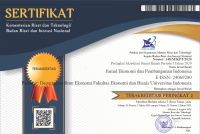Abstract
This study traces the evolution of return to education using large samples from Indonesia Family Life Survey (IFLS). This study apply Mincer Model to find rate of return to education. The rate of return to education decrease from 1993 to 2014 in Indonesia. Interestingly, the declining rate for return to education for men is much larger than for women. Return to education is considerably heterogenic across province and gender. Furthermore, the rate of women is larger than men. Finally, this study find potential experience have not different from 1993 to 1997, but have increased in 2000 and 2014.
Bahasa Abstract
Penelitian ini melihat perkembangan dari tingkat pengembalian investasi pendidikan (return to education) dengan data Indonesia Family Life Survey (IFLS). Penelitian ini menggunakan Model Mincer untuk menentukan tingkat pengembalian investasi pendidikan. Tingkat pengembalian investasi pendidikan menurun dari tahun 1993 sampai 2014. Penurunan tingkat pengembalian investasi pendidikan untuk pria lebih besar dari pada wanita. Hasil tingkat pengembalian investasi pendidikan bervariasi antar-provinsi dan jenis kelamin, namun pada umumnya nilai return pada wanita lebih besar daripada pria. Pengaruh dari pengalaman kerja potensial tidak berbeda dari tahun 1993 sampai 1997, tetapi mulai meningkat di tahun 2000 dan 2014.
References
[1] Bils, M.,&Klenow, P. (2000). Does Schooling Cause Growth? The American Economic Review, 90(5), 1160–1183.
[2] Blundell, R., Dearden, L., Goodman, A., & Reed, H. (2000). The Returns to Higher Education in Britain: Evidence From a British Cohort. The Economic Journal, 110(461), 82–99. DOI: 10.1111/1468-0297.00508.
[3] Blundell, R., Dearden, L., & Sianesi, B. (2001). Estimating the Returns to Education: Models, Methods and Results. London: Centre for the Economics of Education London School of Economics. Diakses dari http://eprints.lse.ac.uk/19536/1/Estimating the Returns to Education Models, Methods and Results.pdf. Tanggal akses 27 Oktober 2013.
[4] Bourbeau, E., Lefebvre, P., & Merrigan, P. (2012). The Evolution of the Returns to Education for 21-to 35-Year-Olds in Canada and across Provinces: Results from the 1991– 2006 Analytical Census Files. Canadian Public Policy, 38(4), 531–549. DOI: http://dx.doi.org/10.3138/CPP.38.4.531.
[5] BPS. (2014). Angka Partisipasi Sekolah (APS) Menurut Provinsi, [2003–2013]. Diakses dari https://www.bps.go.id/ linkTableDinamis/view/id/1054. Tanggal akses 20 Juli 2014.
[6] Card, D. (1999). The Causal Effect of Education on Earnings. In O. C. Ashenfelter & D. Card (Eds.), Handbook of Labor Economics, 3 (Part A), Chapter 30, pp. 1801–1863. DOI: http://doi.org/10.1016/S1573-4463(99)03011-4.
[7] Carneiro, P., Lokshin, M., Ridao-Cano, C., & Umapathi, N. (2011). Average and Marginal Returns to Upper Secondary Schooling in Indonesia. IZA Discussion Paper No 6162. Germany: Forschungsinstitut zur Zukunft der Arbeit – Institute for the Study of Labor (IZA). Diakses dari http://ftp.iza.org/dp6162.pdf. Tanggal akses 27 Oktober 2013.
[8] Ding X., Yang S., & Ha, W. (2013). Trends in the Mincerian Rates of Return to Education in Urban China: 1989– 2009. Frontiers of Education in China, 8(3), 378–397. DOI: 10.3868/s110-002-013-0025-7.
[9] Duflo, E. (2000). Schooling and Labor Market Consequences of School Construction in Indonesia: Evidence from an Unusual Policy Experiment. NBER Working Paper No. 7860. Cambridge, MA: National Bureau of Economic Research. Diakses dari http://www.nber.org/papers/w7860.pdf. Tanggal akses 27 Oktober 2013.
[10] Fersterer, J., & Winter-Ebmer, R. (2003). Are Austrian Returns to education Falling Over Time? Labour Economics, 10(1), 73–89. DOI: http://doi.org/10.1016/S0927-5371(02) 00105-7.
[11] Griliches, Z. (1977). Estimating the Returns to Schooling: Some Econometric Problems. Econometrica, 45(1), 1–22. DOI: 10.2307/1913285.
[12] Harmon, C., & Walker, I. (1995). Estimates of the Economic Return to Schooling for the United Kingdom. The American Economic Review, 85(5), 1278–1286.
[13] Mincer, J. (1974). Schooling, Experience, and Earnings. New York: National Bureau of Economic Research; distributed by Columbia University Press.
[14] Psacharopoulos, G. (1981). Returns to Education: An Updated International Comparison. Comparative Education, 17(3), 321–341. DOI: http://dx.doi.org/10.1080/0305006810170308.
[15] Psacharopoulos, G. (1985). Returns to Education: A Further International Update and Implications. The Journal ofHuman Resources, 20(4), 583–604. DOI: 10.2307/145686.
[16] Psacharopoulos, G. (1994). Returns to Investment in Education: A Global Update.World Development, 22(9), 1325–1343. DOI: https://doi.org/10.1016/0305-750X(94)90007-8.
[17] Psacharopoulos, G. (2006). The Value of Investment in Education: Theory, Evidence, and Policy. Journal of Education Finance, 32(2), 113–136.
[18] Purnastuti, L., Miller, P. W., & Salim, R. (2013). Declining Rates of Return to Education: Evidence for Indonesia. Bulletin of Indonesian Economic Studies, 49(2), 213–236. DOI: http://dx.doi.org/10.1080/00074918.2013.809842.
[19] RAND. (1993). Indonesia Family Life Survey Wave 1 (IFLS1). RAND in collaboration with Lembaga Demografi, University of Indonesia. Diakses dari http://www.rand.org/labor/ FLS/IFLS.html. Tanggal akses 27 Oktober 2013.
[20] RAND. (1997). Indonesia Family Life Survey Wave 2 (IFLS2). RAND in collaboration with UCLA and Lembaga Demografi, University of Indonesia. Diakses dari http://www. rand.org/labor/FLS/IFLS.html. Tanggal akses 27 Oktober 2013.
[21] RAND. (2000). Indonesia Family Life Survey Wave 3 (IFLS3). RANDin collaboration with the Population Research center, University of Gadjah Mada. Diakses dari http://www.rand. org/labor/FLS/IFLS/ifls3.html. Tanggal akses 27 Oktober 2013.
[22] RAND. (2007). Indonesia Family Life Survey Wave 4 (IFLS4). RAND, the center for Population and Policy Studies (CPPS) of the University of Gadjah Mada and Survey METRE. Diakses dari http://www.rand.org/labor/FLS/IFLS/ifls4.html. Tanggal akses 27 Oktober 2013.
[23] RAND. (2014). Indonesia Family Life Survey Wave 5 (IFLS5). RANDin collaboration with the Population Research center, University of Gadjah Mada. Diakses dari http://www.rand. org/labor/FLS/IFLS/ifls5.html. Tanggal akses 30 April 2016.
[24] Selz, M., & Thelot, C. (2004). The Returns to Education and Experience: Trends in France over the Last Thirty-Five Years. Population (English edition), 59(1), 9–47.
[25] Silles, M. A. (2007). The Returns to Education for the United Kingdom. Journal of Applied Economics, 10(2), 391–413.
Recommended Citation
Hendajany, Nenny; Widodo, Tri; and Sulistyaningrum, Eny
(2016)
"Perkembangan Tingkat Pengembalian Investasi Pendidikan Antar-Provinsi: Indonesia Family Life Survey 1993–2014,"
Jurnal Ekonomi dan Pembangunan Indonesia: Vol. 17:
No.
1, Article 4.
DOI: 10.21002/jepi.v17i1.04
Available at:
https://scholarhub.ui.ac.id/jepi/vol17/iss1/4







